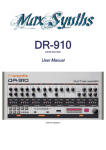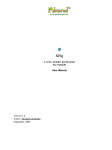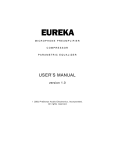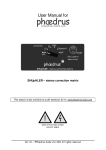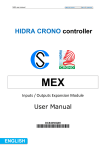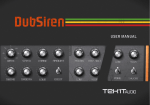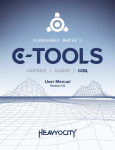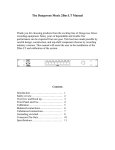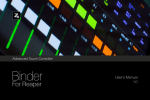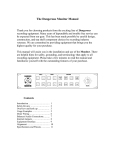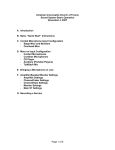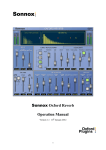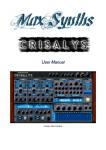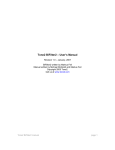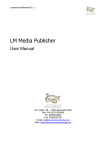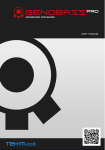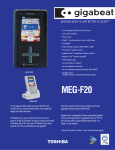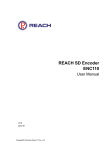Download User Manual
Transcript
DSP-2 VOCAL PROCESSOR UNIT User Manual - DSP-2 Interface - TABLE OF CONTENTS Introduction.............................................................................................................. 3 Features.................................................................................................................. 4 System Requirements............................................................................................. 4 Installation............................................................................................................... 4 Credits..................................................................................................................... 4 Signal Flow.............................................................................................................. 5 User Interface.......................................................................................................... 5 End User License Agreement................................................................................. 8 Contact.................................................................................................................... 10 Introduction Welcome and thank you for purchasing MaxSynths' DSP-2! DSP-2 is a high precision insert effect for vocal processing which includes an Intelligent Dynamic Processor, a saturator, a four band equalizer fixed on vocal key frequencies and a room emulator based on the Schroeder reverberator. DSP-2 has been designed to be an easy to understand solution for all your vocal processing needs. The most important component in the internal circuit is the IDP. The IDP (Intelligent Dynamic Processor) is a dynamic processor unit which is able to automatically program itself depending on the speed of the song and the kind of audio material which is feeded into it. One of the key features of the IDP is a significant increase of the perceived volume, without introducing too much distortion and avoiding that unpleasant “over compressed” sound. The signal flow continues to the saturation stage. The saturator works in three different modes: A, B and C (soft, hard1 and hard2). These three operative modes emulate different saturation types and provide a different amount of saturation and boost at the input stage. Type A is modeled as a soft tape saturation; type C is a tube emulation and type B is a balanced mix between tape and tube saturation. The EQ section provides an immediate control over vocal key frequencies; the EQ settings has been tweaked internally to ensure the best performance with the minimum effort . All controls have been labeled for an easy and immediate use. The Room emulator, based on the Schroeder model, helps to enhance the stereo image and color of the audio material. DSP-2 is the result of a lot of hours of work and research. I really hope it can be useful in order to help people to produce better recordings and improve their production experience! Features • Intelligent Dynamic Processor (IDP) • Four different automatic operative modes: • Fast attack, fast release • Fast A, slow R • Slow A, fast R • Slow A, slow R • Selectable compression ratio • Saturator with three different operation modes • EQ fixed on vocal key frequencies • Room emulator based on Schroeder reverb model • Transparent increment of the perceived volume level • High precision input/output VU-meter • Low CPU usage System Requirements MINIMUM SYSTEM REQUIRIMENTS: PC running WinXP, Vista or W7, CPU 1Ghz with SSE2 support, 512MB RAM, soundcard with ASIO drivers, compatible ASIO host. Installation 1. Close your host (Cubase, Sonar, etc.). 2. Copy the content of the the zip archive into your VST plugins folder (for example: "C:\Program Files\VSTPlugins"). Be sure to copy both the dll file and the "DSP-1" folder. 3. Run your host and do a plugin rescan (refer to your DAW manual). Credits Concept, programming GUI design and manual by Massimo Bosco. Additional Modules by David Haupt and Daz Disley. VST Plugin Technology by Steinberg. VST is a trademark of Steinberg Media Technologies GmbH. Signal Flow User Interface VU-Meter: it's used to monitor the averaging level and reflects the perceived loudness of the material. The VU-Meter is calibrated at -14dBFS (a 1000hz sinusoid waveform at -14dB move the needle to 0). I/O Selector: can be used for comparison purposes, to monitor the difference in the perceived loudness between the unprocessed (in) and processed (out) sound. LOW CUT: engage a low shelf filter to cut unwanted low frequencies like hum noise or to treat popping P’s and T’s. The cut off point can be selected between 80 or 120hz. For most applications 80hz is more than enough. IDP (Intelligent Dynamic Processor): the IDP section is based on the same concept of that available on DSP-1. The internal circuit automatically program itself depending on the speed of the song and the kind of audio material which is feeded into it, and has been tweaked to work with vocal material. Two controls has been added to ensure a better control over the dynamic section. (IDP) ATTACK/RELEASE: as said before the IDP works by automatically set some key parameters for the internal compressor, by the way, given the dynamic nature of vocal material, it's possible to use this control for selecting one of the four available attack/release modes. Different settings for the attack/release parameters can give very different results, depending on the result you wish to achieve choose the one which work better with your audio material. (IDP) COMPRESSION RATIO: it's possible to choose between two different compression ratio settings: 3:1, which is the ideal setting in most cases, or 4:1 for a more compressed sound. (IDP) REDUCTION: the gain reduction led is turned on everytime some compression is occurring on the audio material. Saturation Level: set the desired amount of saturation. The typical usage for common and average level boosts is from "minimum" to middle position (50%). Above the middle position the saturation begins to be more prominent; these kind of settings are recommended only for extreme purposes. Saturation Type: selects the saturation model between A (soft), B (hard1) and C (hard2). The different saturation types can produce different results depending on the kind of audio material and desired results. Since there are a lot of subjective and variable factors it is very difficult to draw strict rules concerning the use of the different saturation types. However this brief description of the different emulation models can be followed as a reference when choosing the most appropriate saturation type: – Type A (soft): soft tape saturation – Type B (hard1): a mix between tape and tube saturation – Type C (hard2): hard tube saturation Equalizer: the equalizer has been conceived as a simple to operate tool which works on vocal key frequencies. The frequency and Q settings for all five bands has been chosen with care and all controls have been conveniently labeled to ensure an immediate control. Is not the purpose of this manual to explain what is the best way to equalize a sound, by the way these general rules can be used as a starting point: AIR: adds brightness to the sound. The switch allows to select between three different boost options: 0 – OFF (the EQ band is turned off, no boost) 1,5 – a +1,5 dB boost is applied 3 – a +3dB boost is applied 6 – a +6dB boost is applied NOTE: too much emphasis in this range can produce sibilance and unwanted artifacts! When the EQ on/off switch is set to OFF the AIR frequency is bypassed (OFF) PRESENCE: adds or cut presence to the sound. CLARITY: increase definition, intelligibility and clarity to the voice. FULLNESS: this is one of the most important frequencies for vocals. Increase to add consistence to the sound. Cut to reduce "boominess". MUDDINESS: as for the FULLNESS control this knob controls another important frequency for vocal tracks. Adding or cutting something here can drastically change the overall sound. Usually it is advisable to cut some decibels in this range to reduce muddiness and make the vocal track sit better in the mix. However, in some cases, it's possible to add some power to the vocals with some db of boost. Room: a room emulator based on the Schroeder model. The aim of the Room section is to enhance the quality of the stereo image and the overal color of the sound. The room emulator can be used to recreate the typical room sound if your vocal take is too dry. To get a better idea of how the sound is modified by the Room emulator, and for fine tuning purposes, is advisable to monitor the sound through a pair of headphones. Most of the times just a bit of room (very low settings) is enough to enhance the overall quality of the sound. Extreme settings are ideal for choir tracks or for creative purposes. Output Level: set the output level of the effect. The default position (no boost) is in the middle (the knob indicator is red). Clip indicator: when on indicates that the output signal is above 0db (digital clipping). To avoid unpleasant results it's very important to check the clip indicator and reduce the overall output level if necessary. Bypass switch: turns the effect unit on/off. CONTROLS Double click: reset a knob to its default position. End User License Agreement License Agreement for MaxSynths DSP-2. PLEASE READ THIS DOCUMENT BEFORE INSTALLING THE SOFTWARE. DSP-2 VST Plugin is copyrighted © 2013 by Massimo Bosco (the "Author"). All rights are reserved all over the world. This End User License Agreement is a legal agreement between you (the "User") and the Author. Using this VST plugin (the "Software") you agree to the terms and conditions of this license agreement. 1) LICENSE (Terms and Conditions) The Author grants you a nonexclusive license to install and use the software on the following terms: a) This software can be used for any private, public, or commercial project or use without limitations but in full respect of the terms of this agreement. b) To prevent illegal distribution of the software every single copy of the software is watermarked with a code that corresponds to the owner of the copy. c) In respect of the term above (1-b) the user may not distribute, lend, rent or sell his personal copy of the software for any reason. The user may not distribute his personal copy of the software in any way. d) According with term 1-b, the user is aware that his copy of the software is specially marked in such a way that if the software is illegally distributed or illegally duplicated, he can be identified and according with International Copyright Laws the Author could decide to proceed against the user. e) Every single copy of the software can be installed only on two personal computers. f) The installation of the software on a computer running as a server is not allowed. g) The user may not reverse engineer or decompile the software. 2) LICENSE TRANSFER a) License transfer is allowed prior direct contact with the Author. b) The license owner must contact us providing detailed informations about the license transfer (full name, e-mail address, the name of the product and the new license owner name and e-mail address). The new license owner will be contacted by us. c) Once the license has been transfered to the new user the previous license owner loses any right to use his copy of the software. d) According with point 2-c the user must uninstall the software from his personal computers(s) and delete any file previously delivered to him after the purchasing of the software. 3) DISCLAIMER AND WARRANTY The software is provided "as is" without warranty of any kind. The author is not responsible for any damage of any kind resulting from the correct or incorrect use of the software. 4) COPYRIGHT Copyright © 2013 Massimo Bosco. All rights reserved all over the world. Contact For any kind of problem feel free to contact us through our website: http://www.maxsynths.com e-mail: [email protected] Milano, ITALY – June 2013 (C) Copyright 2013 Massimo Bosco – All Rights Reserved











